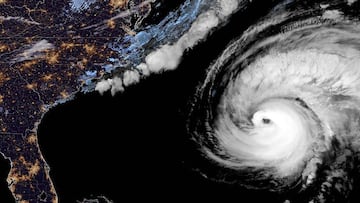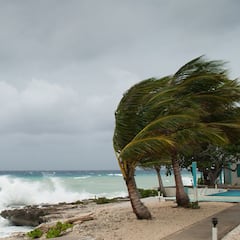What is the eye of a hurricane? What happens inside of one?
One of the iconic features of hurricanes is when an eye forms at the center of the monster storms. But how and why do they form, and what’s it like inside?

The metaphor “to be in the eye of the storm” is relatively recent, and describes being “deeply involved in a difficult or controversial situation which affects or interests a lot of people,” according to the Collins dictionary. Or a period of relative calm before a tumultuous time.
The eye of a hurricane can feel much like that. The relatively calm and cloudless center of tropical storms require certain conditions to form and can vary in size. But if one finds themself in the middle of one, chaos is not far away.
READ ALSO: The strongest hurricanes ever recorded
5-hour animation of 1-minute #GOESWest Visible & Infrared images showed the northern eyewall of Category 2 Hurricane #John it moved inland along the southern coast of #Mexico (west of Puerto Escondido International Airport MMPS). The eye was just off the coast at 0000 UTC/24Sep. pic.twitter.com/lWi9l4Xj06
— Scott Bachmeier (@Wisc_Satellite) September 24, 2024
What is the eye of a hurricane?
Hurricanes consist of three parts, the rain bands, the eyewall and the eye, a circular area at the center of the tempest. A hurricane eye typically forms when sustained winds reach around 74 miles per hour. The size of hurricane eyes generally vary between 20-40 miles across. But they can be as small as 2.3 miles like Wilma in 2005 or expansive like Typhoon Carmen (1960) and Typhoon Winnie (1997) which tied for the largest spanning 230 miles.
The eye of a hurricane is where the barometric reading is the lowest, with the pressure as much as 15 percent lower than the storm outside. The air is also considerably warmer, as much as an 18º F difference at over 8 miles altitude.
The strongest winds are found in the eyewall, which surrounds the hurricane’s eye, the Coriolis force deflects those winds allowing for the opening at the center. While most of the rising air from the eyewall pushes outward, some of it goes into the center. Coming in from all directions, the convergence of the air causes it to sink, creating a warmer environment and evaporating the clouds within.
READ ALSO: Spaghetti models used to track hurricanes
As the sun descended on the fateful night of September 21, 1989, the flammable flow of the Gulf Stream acted as a pull cord for Hurricane Hugo’s laterally chainsawing winds, unexpectedly revving his 34-mile wide eye back up to the intensity of a Category 4 cyclone. Coastal… pic.twitter.com/zPyGEWMQ8q
— Backpirch Weather (@BackpirchCrew) September 22, 2024
What happens inside of the eye of a hurricane?
Within the eye of the hurricane, the weather would seem lovely if it weren’t for the tempest spinning all around it. Typically, the winds blow up to 15 miles per hour and the sun is shining, there may even be birds flying around.
Related stories
However, should you find yourself in the eye of a hurricane, it is recommended to remain sheltered.
The calm before the storm will only last as long as it takes for the other side of the eyewall to reach you. For example, if the eye is 20 miles across and the tempest is moving at 10 miles per hour, it will take two hours for the fury of the hurricane to make its full presence felt once again.



Complete your personal details to comment